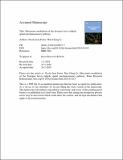Files in this item
Muscarinic modulation of the Xenopus laevis tadpole spinal mechanosensory pathway
Item metadata
| dc.contributor.author | Porter, Nicola Jean | |
| dc.contributor.author | Li, Wen-Chang | |
| dc.date.accessioned | 2019-03-27T00:37:41Z | |
| dc.date.available | 2019-03-27T00:37:41Z | |
| dc.date.issued | 2018-05 | |
| dc.identifier | 252648966 | |
| dc.identifier | 668951cb-d6f8-459a-b0ef-4997aa3a3276 | |
| dc.identifier | 85044570997 | |
| dc.identifier | 000433651600032 | |
| dc.identifier.citation | Porter , N J & Li , W-C 2018 , ' Muscarinic modulation of the Xenopus laevis tadpole spinal mechanosensory pathway ' , Brain Research Bulletin , vol. 139 , pp. 278-284 . https://doi.org/10.1016/j.brainresbull.2018.03.015 | en |
| dc.identifier.issn | 0361-9230 | |
| dc.identifier.other | RIS: urn:1DACB58173837E9B24675B1C86D9A5FE | |
| dc.identifier.other | ORCID: /0000-0002-1179-6636/work/64361133 | |
| dc.identifier.uri | https://hdl.handle.net/10023/17380 | |
| dc.description | This research was supported by a BBSRC studentship to N.J.P. and partially by a BBSRC grant to W.-C. L. (BB/L00111X/1). | en |
| dc.description.abstract | Muscarinic acetylcholine receptors (mAChRs) mediate effects of acetylcholine (ACh) in many systems, including those involved in spinal functions like locomotion. In Xenopus laevis tadpoles at two days old, a model vertebrate for motor control research, we investigated the role of mAChRs in the skin mechanosensory pathway. We found that mAChR activation by carbachol did not affect the sensory Rohon-Beard neuron properties. However, carbachol could hyperpolarise sensory interneurons and decrease their voltage responses to outward currents. Carbachol could increase the threshold for the mechanosensory pathway to start swimming, preventing the initiation of swimming at higher concentrations altogether. Recording from the sensory interneurons in carbachol showed that their spiking after skin stimulation was depressed. However, the general muscarinic antagonist atropine did not have a clear effect on the swimming threshold or the modulation of sensory interneuron membrane conductance. Our results suggest the skin mechanosensory pathway may be subject to muscarinic modulation in this simple vertebrate system. | |
| dc.format.extent | 519418 | |
| dc.language.iso | eng | |
| dc.relation.ispartof | Brain Research Bulletin | en |
| dc.subject | Xenopus laevis | en |
| dc.subject | Swimming | en |
| dc.subject | Muscarinic receptor | en |
| dc.subject | Rectification | en |
| dc.subject | Carbachol | en |
| dc.subject | Mechanosensory | en |
| dc.subject | QH301 Biology | en |
| dc.subject | RC0321 Neuroscience. Biological psychiatry. Neuropsychiatry | en |
| dc.subject | E-NDAS | en |
| dc.subject.lcc | QH301 | en |
| dc.subject.lcc | RC0321 | en |
| dc.title | Muscarinic modulation of the Xenopus laevis tadpole spinal mechanosensory pathway | en |
| dc.type | Journal article | en |
| dc.contributor.sponsor | BBSRC | en |
| dc.contributor.institution | University of St Andrews. School of Psychology and Neuroscience | en |
| dc.contributor.institution | University of St Andrews. Institute of Behavioural and Neural Sciences | en |
| dc.identifier.doi | https://doi.org/10.1016/j.brainresbull.2018.03.015 | |
| dc.description.status | Peer reviewed | en |
| dc.date.embargoedUntil | 2019-03-27 | |
| dc.identifier.grantnumber | BB/L00111X/1 | en |
This item appears in the following Collection(s)
Items in the St Andrews Research Repository are protected by copyright, with all rights reserved, unless otherwise indicated.

